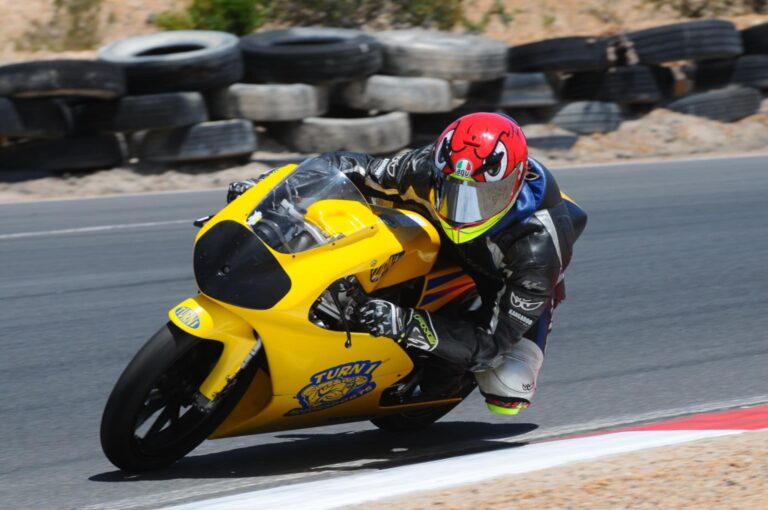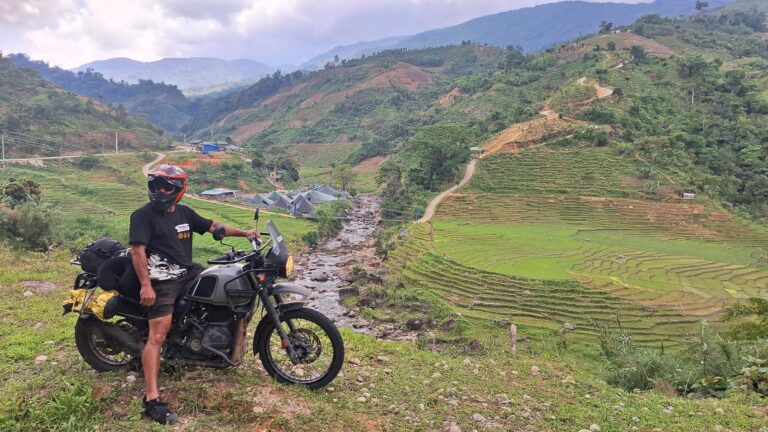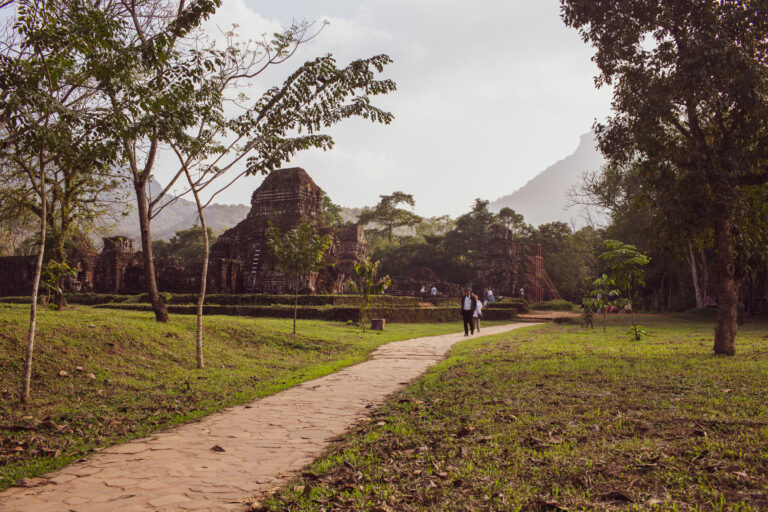
Home > Blog > Destinations > Saigon’s Soul: Motorbike Adventures in Ho Chi Minh City
Saigon’s Soul: Motorbike Adventures in Ho Chi Minh City
Share:
- Published:
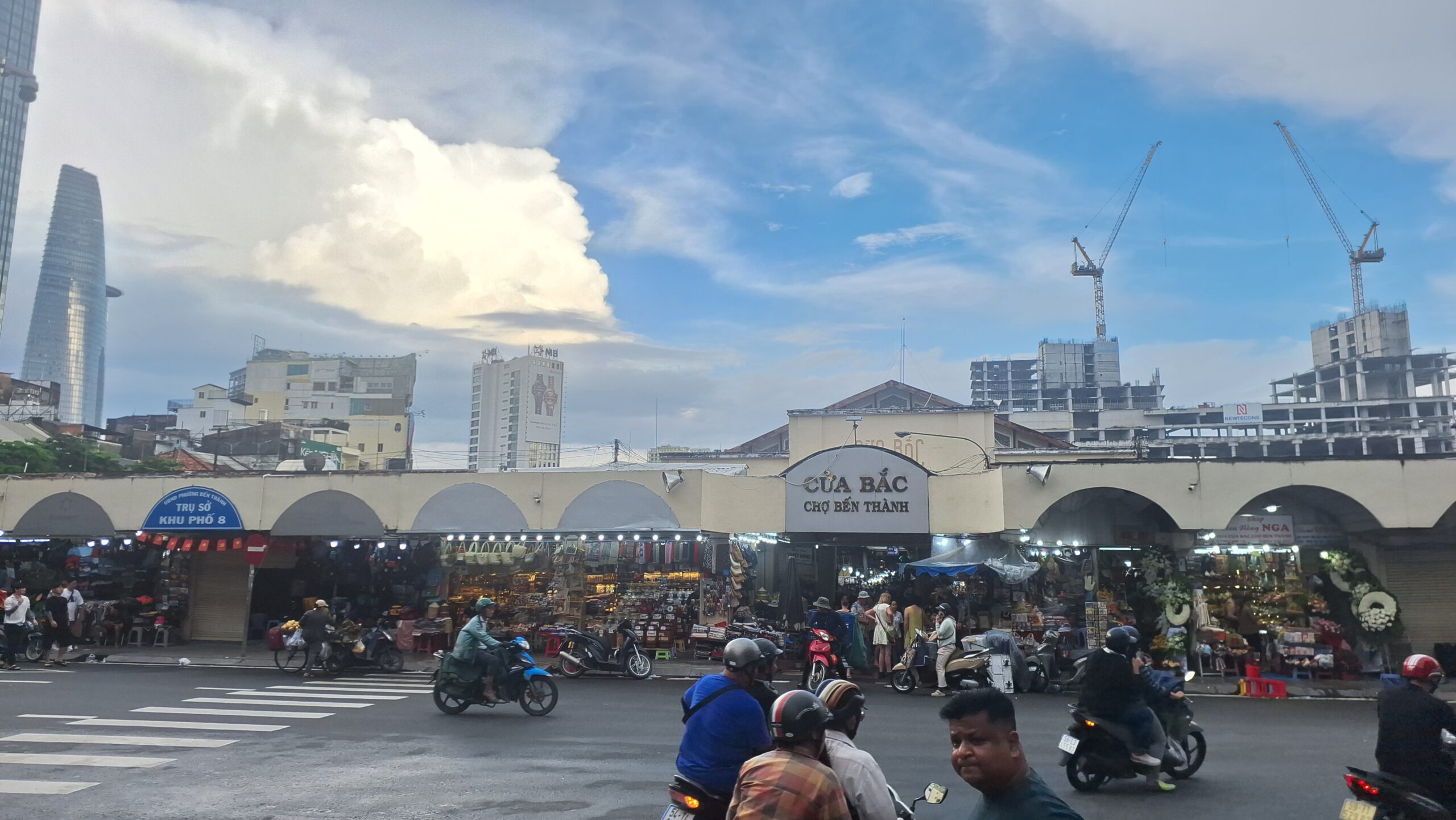
Saigon is a kinetic beast powered by over 8 million motorbikes, creating a one-of-a-kind background soundtrack that dominates the city. Officially and interchangeably called Ho Chi Minh City, Saigon is the largest city in Vietnam and bustles with the kind of energy only a densely-packed metropolis of some 10 million can create. To say it’s a unique is an understatement: It’s a blend of striking modernity, historical relics, and a highly developed economy mixed with an enormous and laid-back informal, alleyway economy.
Driving in Saigon is its own thrill and its own skillset. Getting around on two wheels is the way most of the city’s inhabitants travel, and it’s a way to understand the city’s soul. It’s a city made for, of, and by motorbikes.
Navigating the city’s traffic maelstrom can lead to a wide variety of adventures, hidden gems, and the city’s vibrating pulse. Whether you’re looking for relaxed coffee shops, top-tier food, wild nightlife, or just about anything else, Saigon has it in spades.
For those already curious, check out our tours that involve Saigon:
North to South Classic
Hoi An to Saigon Central Highlands Adventure
Whether you’re a novice rider or a veteran, Saigon’s streets are calling. Let’s explore the city here to give riders an idea of just what to look for in your motorbike adventure in Ho Chi Minh City. First, though, we need to talk about the driving itself.
Table of Contents
Navigating the Chaos: Driving in Saigon
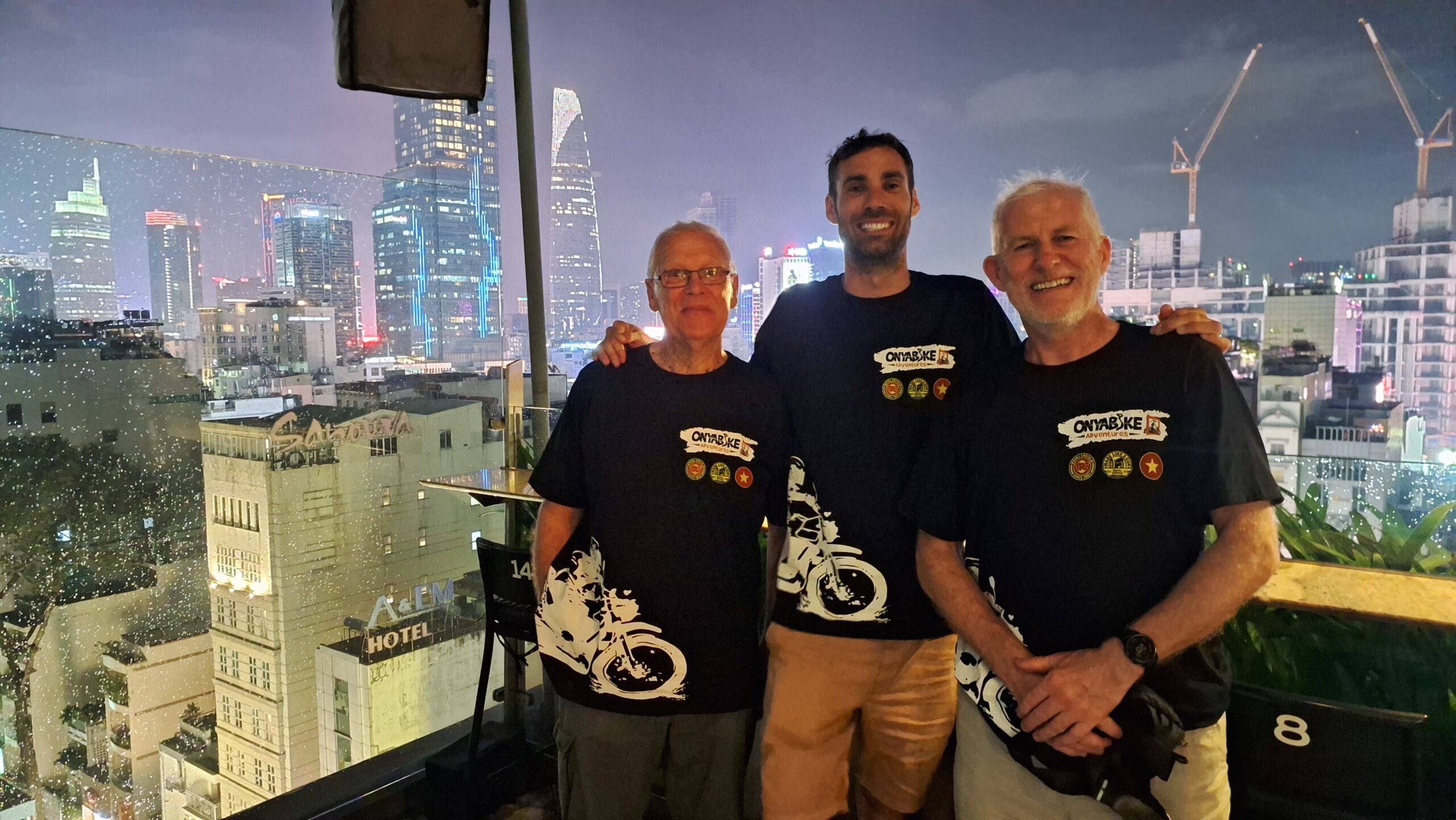
Picture this: You’re at a District 1 crossroads right in the heart of the city, one motorbike in a swarm of bikes that move like a school of fish. The light flips green, and the pack surges — a fluid, fearless wave of riders. In Saigon, motorbikes rule the roads, parting cars and dodging pedestrians in a hypnotic, almost hive-mind dance. Riding here demands instinct be turned on at all times, as order and rule-following are far from guaranteed. Riders should always expect the unexpected, and keep their head on a swivel.
Compared to decades past, far more cars prowl Saigon’s streets than previously. Because streets have rarely been widened, this can mean heavy traffic, especially during rush hour. Motorbikes weave in and out of gaps wherever possible, often riding on sidewalks to bypass bottlenecks. It’s just the way things go. These bottlenecks can be caused by buses, poorly parked cars, street vendors, or goodness knows what else. Anecdote: The worst traffic jam I observed in Saigon was caused by a man with a banana stand blocking a whole lane on one of the busiest streets in town.
Honking is ubiquitous. Unlike many Western countries, it’s not a rude or aggressive thing — not always, at least. A polite honk from a bike can simply mean “I’m here” or “I’m passing you,” whereas from a car it can mean “Get out of my way.”
Given all this chaos, safety is paramount. Always wear a helmet (it’s mandatory and enforced by fines) and consider wearing long pants if you want to avoid burns from motorbike exhausts, commonly called “Saigon kisses” by those who’ve been unlucky enough to experience them.
When you master the flow of riding in traffic, Saigon becomes yours. Zipping between districts reveals a quite varied city, with lots to offer. Let’s take a look at some of these districts and what to expect.
Exploring Saigon’s Districts
Saigon’s districts are a unique mosaic of history, culture, and modernity, each offering unique experiences. From District 1’s electric core to District 7’s polished suburban sheen, here’s your guide to the must-visit zones.
District 1: The Vibrant Heart
District 1, as astute readers may guess, is the center of Saigon, and its beating pulse. Its neon-lit boulevards, narrow alleyways, and colonial relics make it a rider’s playground and an easy — and entertaining — place to get lost. Start at Ben Thanh Market, a 1914 bazaar where you can haggle anything from scarves to food and more. Be aware that vendors are extremely used to foreigners here and will often price gouge. If something doesn’t seem worth your money or seems overpriced, walk away. Vendors make a living gouging naive foreigners.
Head north to the French Quarter, including Notre Dame Cathedral, built in 1880. Its spires tower over selfie-takers, while the Central Post Office, with the original structure designed by no less than Gustave Eiffel, can make another scenic stop.
The Reunification Palace, a 1960s time capsule, offers a glimpse into the wartime history of the city and is well worth a visit. It functions as a museum now, with war rooms depicting command and control centers. Its cheap entry and beautiful grounds make it a must-stop. Oh, and there are tanks and helicopters there too, which are pretty cool.
In the evening, Nguyen Hue walking street is a vibrant hub for just about everything. It’s one of the best people-watching spots in town and is consistently one of the busiest areas of an already-busy area. It’s a great spot to start a night out and get a feel for where you want things to go for the evening. For reference, we park our bikes outside of the craziest traffic in D1 and take Grab taxis to limit stress and driving so we can all enjoy the evening.
The food scene is one of the most vital parts of any District 1 exploration, with countless restaurants, streetside vendors, alleyway gems, and fine dining all readily available. We recommend checking out our article on the best street food in Vietnam to really get a glimpse of what you can dive into.
Western food is widely available in Saigon, with some top-quality food as the city continues to up its game. Those looking for excellent fish and chips, for example, would do well to check out Union Jack’s, serving some of the best fish and chips in Asia.
A necessary stop for any tourist in Saigon is Bui Vien Street, a walking street known for its late-night party vibe, cheap beers, and thumping music. The bars around Pasteur Street offer their own variety of fun and are also late-night haunts for those looking for lively nights.
If you’re in District 1, simply taking a turn down an alley can lead to fantastic food, unplanned adventures, and fond memories. Dive in and enjoy.
District 2: Expat Enclave, Riverside Chic
Across the Saigon River, District 2 is home to upscale expat vibes and riverside charm. Thao Dien, its heart, is a magnet for international residents, with leafy streets and modern cafes perfect for a relaxed ride. Cross Thu Thiem bridge, a 2-km sweep with river views, and cruise down Tran Nao street, lined with villas and bistros.
Stop at The Deck for riverside cocktails of Anan Saigon’s rooftop for Michelin-starred pho (reservations recommended). Check out Sala Park’s weekend markets, where you can find food trucks and a number of locally-made goodies. Pop into Buddha Bar for a pint at a classic late-night haunt or to catch up on the latest live sports.
Because District 2 changes so fast, we simply recommend cruising down streets and seeing what appeals to you. Expect higher prices than in some parts of the city, but with quality to match it.
An important note about District 2: Because it was built on a swamp, the roads are liable to flooding during the rainy season. They can even flood when it’s not the rainy season and simply high tide, since the Saigon river is tidal. Watch for high water and take alternate routes if possible rather than choke out your exhaust.
District 3: Colonial Charm and Local Vibes
North of District 1, District 3 offers a peaceful contrast to the buzz of District 1. Its tree-lined avenues, with enormous, ancient trees, combined with French era-villas offer an inviting ride, and its wide boulevards ensure traffic flows relatively smoothly. As always, alleys hide hidden gems.
Start at the Jade Emperor Pagoda, a 1909 Taoist shrine replete with dragon motifs. The Fine Arts Museum’s colonial halls display rural murals, while the former Fitzsimmons Army Hospital reminds visitors of the city’s wartime history. Be sure to catch the War Remnants Museum, a muse-see for any visitors interested in the history of the war.
Foodies can revel in District 3, with restaurants like Xoi Xoi offering up mounds of sticky rice with pork and quail eggs. Hong Phat restaurant, a Michelin Bib Gourmet destination, offers its unique noodle dish, with Khmer influences. Turtle Lake is a good park to catch some weekend vibes, and is close to District 3’s Pizza 4P’s — a Japanese-influenced pizza restaurant with a well-earned reputation for delicious food and good service.
Check out Acoustic bar for nightly live music with some good local talent. Rooftop bars are also popular in the area, giving excellent views of the city at night.
District 5: Chinatown’s Busling Heritage
Cholon, or District 5, is an enclave of Teochew Chinese heritage, to the west of District 1. Its incense-heavy air and gold shops demand nimble riding, as streets can get very clogged with traffic here. Cross Nguyen Trai bridge into Tran Hung Dao, and check out Binh Tay market — a 1928 labyrinth of everything from jade to dried shrimp. Keep your bartering skills handy.
Check out Thien Hau Pagoda’s spiraling coils honoring the sea goddess, and relax at Ong Bon pagoda in quieter vibes featuring dragon-boat murals.
Food in District 5 is king, and often an informal affair. Chuyen Beo’s xiu mai dumplings of Nam Giao’s Hu Tieu Nam Vang (Cambodian-Vietnamese noodles) draw crowds. Bo Bia (Popia), a unique type of spring roll, is common in this area and worth trying.
If you really want to do district 5 on the fly, we recommend picking a random alley and zipping down it, looking for food stands that “look right.” Look for places packed with locals, as they certainly know where the good food is. District 5 is not known for its nightlife, so keep your visits to daytime and evening.
District 7: Suburban Shine and International Flair
South of District 1, District 7 offers a fairly polished escape, bordered by district 4 to the northeast and district 8 to the northwest. There are essentially two District 7’s: The very locally-Vietnamese northern part, and the international and polished Phu My Hung, a corporation that essentially acts as its own city.
Phu My Hung is a planned upscale community, home to many thousands of Koreans and Westerners alike, and is largely considered Koreatown. It’s Saigon’s suburban gem, but with walkable streets, high-rise apartments, countless restaurants and bars, and high-end malls. It’s an exceptionally popular place to raise a family. Because it’s on the southern end of town and gets some sea breeze, air pollution here is lesser than in other parts of the city.
Check out Crescent Lake, where a number of cafes and restaurants ring the lake and give pleasant outdoor vibes. It’s part of an enormous mall with all kinds of western-style amenities. SC VivoCity Mall, on the other side of Phu My Hung, offers similar vibes, though less outdoorsy.
Sky Garden, a mixed-used high-rise and business center, has a number of bars and restaurants nearby, including the several blocks to its east. South of Nguyen Van Linh, the main thoroughfare through the area, Phu My Hung stretches out, with expat-friendly restaurants and top-end Vietnamese fare dominating. A tip: If you happen to drive by Pho Hung, stop and get it. It’s some of the best in town.
District 7 offers a decent nightlife, though not one that goes all night. Check out The Tavern in Phu My Hung for British comfort food, sports, live music, trivia nights, and a friendly crowd.
Binh Thanh: Emerging Edge and Riverside Rides
Across the Saigon River, Binh Thanh blends gritty roots with new towers, bordering Districts 1, 3, Phu Nhuan, and Thu DUc. Enter via the Thu Thiem bridge for river views, then ride to Than Da Island’s coconut groves and crab shacks in Ward 22. Ward 19’s Bloom hotel area buzzes with rooftop bars like EON51, serving fusion tapas.
Landmark 81, Vietnam’s tallest building at 461 meters, dominates the skyline. Check out the observatory (300k vnd entrance fee) for panoramic views of the city. Evening cruises can give dazzling views of riverfront neon signs, while pho carts in Ward 25 serve locals. Binh Thanh looks like the future of Saigon, and probably all of Vietnam.
Saigon’s Coffee Culture
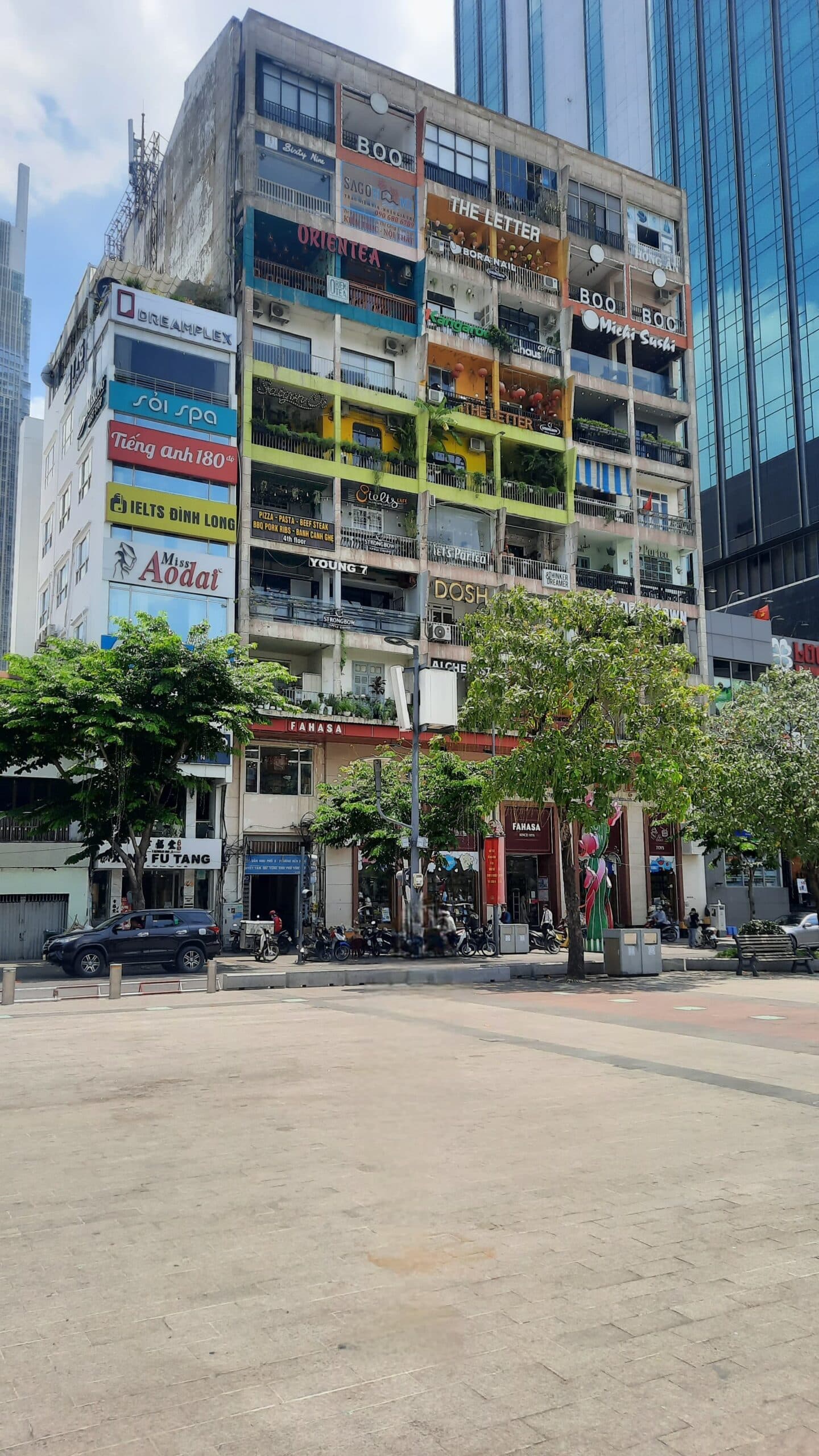
Saigon’s coffee culture is a religion. Its robusta beans, sidewalk brews, and high-end coffee shops fuel a city that basically never sleeps. Motorbiking the city unlocks this caffeinated soul, lett you zip between districts to dip into Vietnam’s coffee obsession. From traditional ca phe sua da (iced milk coffee) to a number of creative inventions, be sure to spend some time finding out what Coffee in Saigon is all about. That building you see above, for example? It was an apartment building, but now each apartment is its own coffee shop.
We’ve written about coffee in Vietnam before, so check out our article on Vietnam’s coffee culture for more details (linked in this sentence).
Coffee in Saigon is a French colonial heirloom that the Vietnamese have made all their own. The iconic ca phe sua da is a streetside ritual, usually costing anywhere from 10-20k vnd (around $.50-$1). Coffee stalls can be found on literally every corner and alley, so you will never need to worry about where to get your caffeine fix.
High-end and unique coffee shops are an enormous part of the culture as well. Take Cong Caphe, for example, with its retro Viet Cong vibe, which serves coconut coffee and nostalgia. Many coffee shops offer courtyard seating, a welcome and quiet retreat from the hustle and noise of the city.
District 2’s Thao Dien is an expat coffee haven. The Workshop on Ngo Duc Ke offers pour-overs with river views, beans sourced from Da Lat’s highlands. Nearby, Bosgaurus Coffee roasts on-site, its earthy blends drawing digital nomads. Wide roads ease navigation, but morning school runs clog Tran Nao—ride early. District 7’s The Coffee House near Crescent Lake serves ca phe sua da with skyline vistas, perfect for sunset stops. Its open boulevards suit novice riders craving calm.
Binh Thanh’s rooftop scene shines. EON51, atop Landmark 81, pairs espresso with 360-degree views—a splurge worth the ride. Ward 25’s floating cafes, reachable via riverside paths, offer tea and coffee on moored boats, the Saigon River reflecting neon. For tradition, Cholon’s District 5 hides hem stalls where elderly vendors brew phin-filter coffee, slow-dripped over condensed milk. Nguyen Trai’s chaos tests your weave, but the reward is authentic.
Specialty coffee is thriving in Saigon, with barista-led tastings, more common use of Arabica-Robusta blends, and Instagram-worthy aesthetics. You could try to visit a new coffee shop in Saigon every day for years and never scratch the surface — so report back to us with what you find.
Beyond the City: Urban Trips by Motorbike
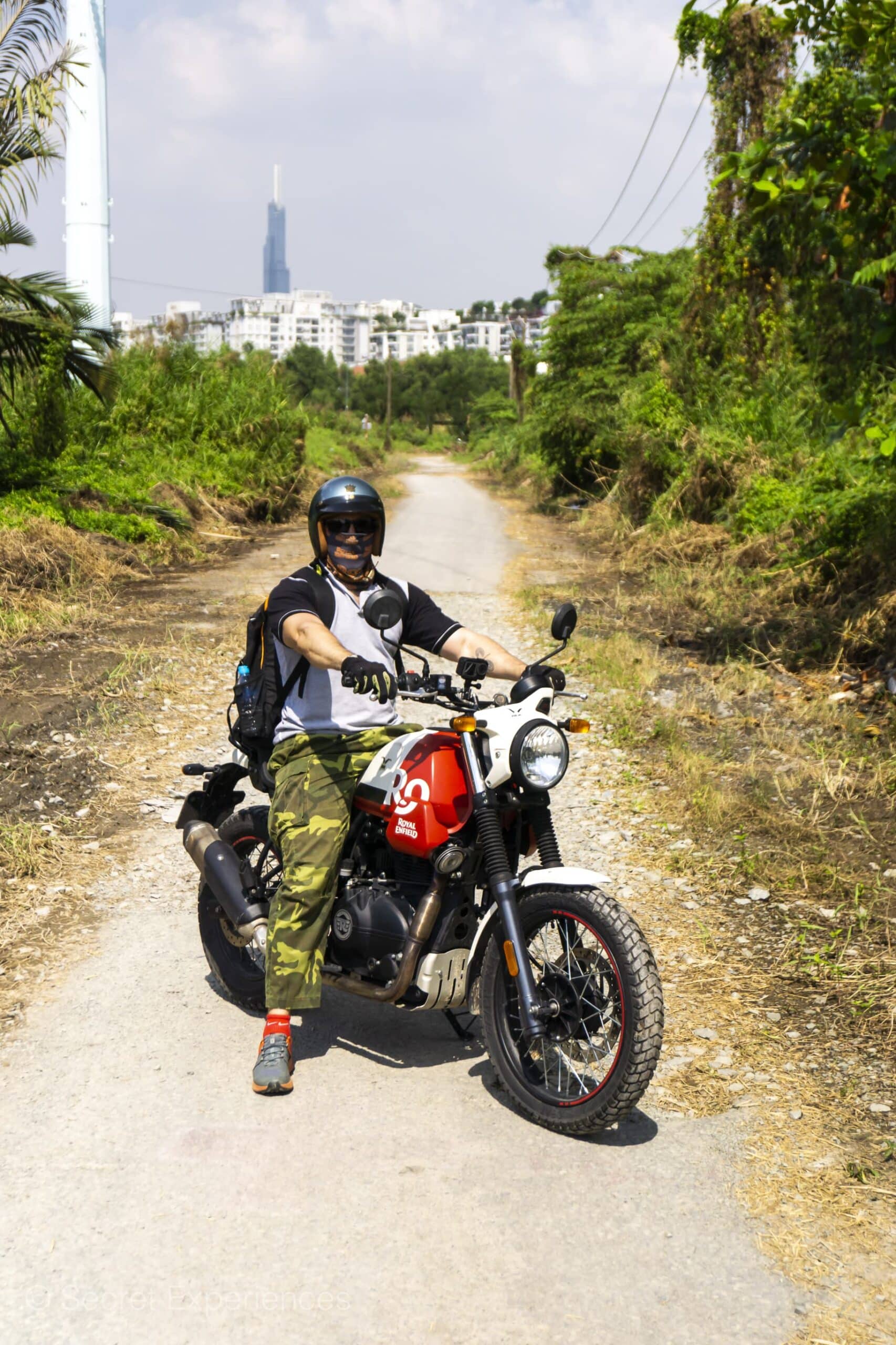
Saigon’s urban roar eventually fades into green escapes, and your motorbike is the key to getting out. The Cu Chi Tunnels, some 70 kilometers northwest, take about 1.5 hours to get to and are worth a visit for those wanting to know more about the war. This 250-kilometer network of tunnels demonstrates wartime strategies and all that soldiers had to go through. Those interested can fire an AK-47 for an extra charge. It’ll feel a bit like time travel. A note: For those of larger builds, fitting into the tunnels can be quite a challenge.
Heading south to the Mekong Delta, riders can get to My Tho, around 70 kilometers and 2 hours away. Here you’ll find waterways, orchards, farms, and lots of greenery. Take a ride on sampans through coconut canals, feast on local fish and seafood dishes, and enjoy the relaxation. If you’re keen to see more, head down to Can Tho to see another one of Vietnam’s largest cities, though one that’s often underdiscussed.
Further south from My Tho is Ben Tre, the coconut capital of Vietnam. It’s known for its chill vibes and, you guessed it…coconuts. Seriously, you’ll never see so many coconuts again in your life. They’re famed for their sweetness and shipped throughout the country.
Heading southeast from Saigon leads you to Vung Tau, taking around 2 hours for the 100 kilometer trip. Vung Tau is a popular seaside destination for Saigoners, especially on the weekends, with its (decent but not stellar) beaches. An enormous statue of Jesus, the Christ of Vung Tau, sits atop Nho Mountain, overlooking the city. Enjoy the plentiful and fresh seafood here.
Exploring Vietnam's Beating Heart
Motorbiking Saigon is a love letter to a city that thrives on motion. From District 1’s neon chaos to District 7’s polished suburban glow, and from Cholon’s incense to Binh Thanh’s riverside high-rises, each district tells a story. District 2’s expat chic and the Mekong green add depth, while coffee fuels the whole city.
Even with the rise of cars, motorbikes remain Saigon’s soul. The magic lies in the shared lanes, the near-misses, and the ever-present possibility of hidden gems down unnamed lanes.
Check out our trips that involve Saigon:
North to South Classic
Hoi An to Saigon Central Highlands Adventure
As always, give us a shout if you want to further discuss a Vietnam motorcycle adventure — whether it’s one we’ve already planned or a custom tour. Your adventure awaits!
Related Posts
Recent Posts


